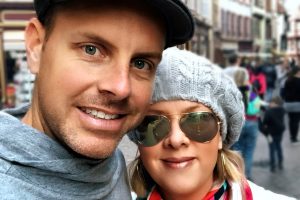The Incredible Egg
A couple of weeks ago, I was asked to come to Oregon to take a tour of a working egg farm, along with 8 other bloggers. We were joined by a few folks from the American Egg Board, Food Nutritionist Mary Donkersloot, Howard Helmer, The World’s Fastest Omelet Maker, and Food Network and the Cooking Channel’s Chef Jeffrey Saad. For 2 days, we toured, we ate, we cooked. We asked questions. We ate some more. We soaked in an incredible amount of information. And we ate. A lot.
 I don’t know about you, but I use a lot of eggs. Before I started blogging, it would take us a month or more to go through a 12 count carton of eggs. In fact, I would end up buying the 6 count, because we just plain didn’t cook. Ever. But that time has come and gone, and these days, I hate having less than 36 eggs in the fridge at any given moment. It is nothing for me to go through a dozen in a day, depending on what I am making or if I have a cake order. But it isn’t just cakes I use them in…I make macarons. Brownies. Meringue. Cookies, creme brulee, pudding, popovers. And then we eat them in other ways too – scrambled, omelets, fried. I had never been brave enough to attempt poaching an egg before the trip to Oregon, but a one on one lesson with Chef Saad cured me of that fear. I guess what I am trying to get at it this: I use a lot of eggs.
I don’t know about you, but I use a lot of eggs. Before I started blogging, it would take us a month or more to go through a 12 count carton of eggs. In fact, I would end up buying the 6 count, because we just plain didn’t cook. Ever. But that time has come and gone, and these days, I hate having less than 36 eggs in the fridge at any given moment. It is nothing for me to go through a dozen in a day, depending on what I am making or if I have a cake order. But it isn’t just cakes I use them in…I make macarons. Brownies. Meringue. Cookies, creme brulee, pudding, popovers. And then we eat them in other ways too – scrambled, omelets, fried. I had never been brave enough to attempt poaching an egg before the trip to Oregon, but a one on one lesson with Chef Saad cured me of that fear. I guess what I am trying to get at it this: I use a lot of eggs.
That being said, I’ve always bought conventional eggs. Meaning, the cheaper, white, plain old eggs. I always buy large but that’s just me. Most recipes call for large, so I buy large. It’s easier. But I‘ve seen the others. The Organic Eggs. The Cage Free Eggs. The Free Range Eggs. They always cost more, and because I go through so many, I just don’t consider the others as an option.
However, there is a huge movement going on these days, in case you haven’t noticed. People are clamoring for anything labeled Organic. I personally am not one of these people, but that doesn’t make my opinion wrong. We all have choices to make. And when it comes to purchasing eggs, I’d like to tell you what I witnessed, so that you can be a little better informed in your buying decisions. I am NOT trying to tell you what to do, what to buy, what to think. These are only my observations, and I encourage you to do your own research. Only YOU can decide what is right for your family.
Our tour began at Willamette Farms, a family owned and operated egg farm outside of Portland, Oregon. The Willamette Farm is diverse, in that they had different types of eggs. Organic, Cage Free (or Aviary), and Conventional. The first chicken house we toured was the Organic.
Maybe you are under the same impression that I was. Organic, Free Range Chickens are, well, roaming around on the range. You know, pecking at the ground, soaking in the blue sky, kind of like those happy cows in the California Cheese commercials. Lots of chickens out in the field who come home at night to roost, and lay their eggs before heading back outside to play again the next day. Sound about right?
 Silly us. Think about the commercial feasibility of that. Wal-Mart sells Organic Free range Eggs. It’s just not possible for this to be the scenario on a scale that enormous. For one thing, you can’t just have chickens running loose in a commercial chicken farm. There are rodents, predators, and the potential for diseases
Silly us. Think about the commercial feasibility of that. Wal-Mart sells Organic Free range Eggs. It’s just not possible for this to be the scenario on a scale that enormous. For one thing, you can’t just have chickens running loose in a commercial chicken farm. There are rodents, predators, and the potential for diseases  like bird flu. It’s too risky, and just not plausible on a scale that large. The fact of it is this – we entered a long, narrow, quite dark building, (seen above) packed to the gills with loose chickens. Think 7500 chickens. All brown chickens. All with beaks, and for some reason, they loved pecking at my feet, which were luckily covered in a special blue outfit the farmers provided us to protect both the bloggers as well as the chickens. Anyway, these 7500 chickens could mill around in the room, or go through one of 3 doggie doors to en enclosed screened in porch. Not many chickens were out there – so I’m not sure if they even knew they could. So, no wide open spaces, no pecking at the grass, no getting a suntan. Just a room packed full of squawking chickens. It was very Hitchcockian, and most of use were relieved to get out of there. Were the chickens mistreated? Not that I could see. But here is the thing. The only way to be a certified ORGANIC egg is to be from a Free Range Chicken. So, they get organic feed. That’s the difference. The downfall to this system is that chickens aren’t super smart, and even though most of them will find a place to roost, some don’t, and lay their eggs any old place. There’s the “litter” of 7500 chickens in that room, and eggs lay in it sometimes. Another downfall is that the eggs from the Organic house are only collected a couple of times a week, which means while they aren’t OLD by any stretch, they aren’t as fresh as a conventional egg.
like bird flu. It’s too risky, and just not plausible on a scale that large. The fact of it is this – we entered a long, narrow, quite dark building, (seen above) packed to the gills with loose chickens. Think 7500 chickens. All brown chickens. All with beaks, and for some reason, they loved pecking at my feet, which were luckily covered in a special blue outfit the farmers provided us to protect both the bloggers as well as the chickens. Anyway, these 7500 chickens could mill around in the room, or go through one of 3 doggie doors to en enclosed screened in porch. Not many chickens were out there – so I’m not sure if they even knew they could. So, no wide open spaces, no pecking at the grass, no getting a suntan. Just a room packed full of squawking chickens. It was very Hitchcockian, and most of use were relieved to get out of there. Were the chickens mistreated? Not that I could see. But here is the thing. The only way to be a certified ORGANIC egg is to be from a Free Range Chicken. So, they get organic feed. That’s the difference. The downfall to this system is that chickens aren’t super smart, and even though most of them will find a place to roost, some don’t, and lay their eggs any old place. There’s the “litter” of 7500 chickens in that room, and eggs lay in it sometimes. Another downfall is that the eggs from the Organic house are only collected a couple of times a week, which means while they aren’t OLD by any stretch, they aren’t as fresh as a conventional egg.
 The second house we toured was the Cage Free Aviary. In here, the chickens are not raised on the Organic Feed, because they wouldn’t be able to be labeled Organic, anyway, because they aren’t Free Range. They have a better system here in my opinion. For four hours each day, the chickens are contained in larger cages together, so that they can lay their eggs in a cleaner environment. Then beep, beep, beep – the cage doors open up and for the next 20 hours they roam around in a big concrete room. Again, not all of the chickens even bothered leaving the cage. I mean, what’s fun about a concrete room? But, it’s clean, and it works. So that’s what you get with a Cage Free Label.
The second house we toured was the Cage Free Aviary. In here, the chickens are not raised on the Organic Feed, because they wouldn’t be able to be labeled Organic, anyway, because they aren’t Free Range. They have a better system here in my opinion. For four hours each day, the chickens are contained in larger cages together, so that they can lay their eggs in a cleaner environment. Then beep, beep, beep – the cage doors open up and for the next 20 hours they roam around in a big concrete room. Again, not all of the chickens even bothered leaving the cage. I mean, what’s fun about a concrete room? But, it’s clean, and it works. So that’s what you get with a Cage Free Label.
A funny fact? Both the Cage Free and Free Range chickens are brown, and lay brown eggs. Why? Because the consumer assumes that a brown egg is more organic, more natural. That’s just not true. The white chickens would lay just as “organic” and egg as the brown chicken, but we as shoppers just won’t buy it.
The last tour was of the Conventional Chicken House. 6 to 8 chickens per relatively small cage, conveyor belts carrying away the litter constantly, the eggs continually being conveyed to the collection facility. It is very clean, very organized, very overwhelming! Close to two million chickens in ONE room, and it was exponentially cleaner in there than in the Free Range house. The chickens were cramped, yes, but they could move around, eat, do their thing. The eggs in the conventional house were typically in your store the NEXT DAY. Super fast turn around.
Once the eggs in any house go to the packaging facility, they are cleaned, checked for defects, assorted by size, and packaged in a variety of containers – from dozens to crates. Eggs that didn’t look nice but were still perfectly healthy were sent off to another facility to be turned into egg product, such as restaurant packs of scrambled eggs, hard boiled eggs, and deviled egg kits. There is very little waste in the egg industry, At least at Willamette. it was run in a very sterile, very systemized fashion. There is a USDA/Health inspector on site everyday. Constantly. Feel good about that… I do.
 So, after all I have seen, I still buy the conventional eggs. Perhaps I am naive, but I think the best solution would maybe be to raise the Cage Free Chickens to be “organic”, as that would allow for a cleaner egg, a cleaner facility, and happier chickens. I don’t see much good in that Free Range scenario – the chickens have less disease and don’t fight as much in the Cage Free environment. But that’s not an option, as the government won’t allow any eggs to be labeled organic in that scenario. Kind of sad.
So, after all I have seen, I still buy the conventional eggs. Perhaps I am naive, but I think the best solution would maybe be to raise the Cage Free Chickens to be “organic”, as that would allow for a cleaner egg, a cleaner facility, and happier chickens. I don’t see much good in that Free Range scenario – the chickens have less disease and don’t fight as much in the Cage Free environment. But that’s not an option, as the government won’t allow any eggs to be labeled organic in that scenario. Kind of sad.
I hope this has given you a few things to think about, and not bored you to tears.
I’ll be talking more about eggs in a later post, with information provided to us by the food nutritionist. I’ll also be demystifying the egg poaching process…and maybe even videoing it for you, if I can get over my fear of being on camera! Tell me – is that something you would be interested in learning? Would you watch it if I made a video? Would you watch it if I gave some cool stuff away in the post? (That’s a real question, don’t ignore it.)
In the meantime, want to meet my fellow Good Egg Bloggers? Of course you do…
- Amy of She Wears Many Hats (with me, above, after we made a Toad in the Hole)
- Jennifer of Savor the Thyme
- Michelle, standing in for Mandy of Gourmet Mom on the Go
- Lynn of Lynn’s Kitchen Adventures
- Dara, of Cookin’ Canuck
- Kelsey of The Naptime Chef
- Erin of Prudence Pennywise
- Kristy of The Wicked Noodle
*Disclaimer – the trip to Oregon was paid for by the Good Egg Project. However, all thoughts are my own, and were not sponsored in any way. Also, my boobs look pretty awesome in that picture with Amy. I don’t have a clue how that happened.







